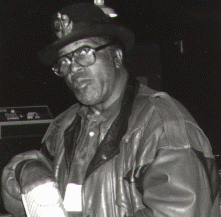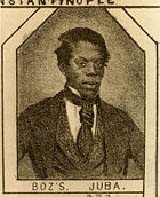Shave and a Haircut: Two Bits

Bo Diddley, photo by Kenric L. Ashe
Or: The Hambone, Hand Jive & Boz's Juba
By David Cranstoun Welch
(August 2008)
For some older listeners, the reliance of today's reining pop format,
R&B on gyrating, sweat-drenched dance routines is at odds with the spirit of popular music. It somehow seems like subterfuge, it's absurdly over-sexualized shimming appearing to mask the music's supposed unoriginality and lack of solid hooks. Of course, this opinion is expressed more often than not by the generation that came of age sometime in the late 1970's and '80s and missed out on an earlier period when Pop and R&B were just as entwined as today and seemed almost entirely concerned with generating the latest dance craze, from Chubby Checker's Twist to Johnny Otis' Hand Jive.
The Hand Jive was a dance associated with R&B and early Rock n' roll and first rose to popularity in the late 1950s. It involved an intricate pattern of handclaps on various parts of the body which follow and imitate the percussion instruments. Fundamentally, it was a more refined version of the schoolyard game of Pat-a-cake.
The Hand Jive involved thigh slapping, cross-wrist slapping, fist pounding, elbow touching and a move known as the hitch hike. The Hand Jive had its roots in much earlier forms of African American musical expression like the Juba Dance or the 'hambone,' both known by the earlier term of 'Pattin' Juba,' which itself derives from the African 'Giouba.'
Pattin' Juba was a stylistic melting-pot that incorporated all of the key elements of the Hand Jive, including the stomping, patting and slapping of various body parts along with the more surprising inclusions of Dutch Clogging and the Irish Jig. It also incorporated elements of the mid 19th century slave and minstrel dances known as the 'Walkaround' and the 'Cake Walk' which was itself an Africanization of European dance forms like the French Quadrille.
The Quadrille was a multi-part French square dance birthed in the royal courts of the late 18th century, and can be found cited in the pages of Balzac; quite a remove from the plantations of America's Southern States. However, this seemingly remote dance music of the French Nobility can be found echoing through African American culture as late as the 1940s in a series of piano performances by Jazz Musician Jelly Roll Morton.
This remarkable cross pollination of white and black cultures stretches back as far as the arrival of the first slaves in the new world and has had an incredible impact on all the nations it has touched from Trinidad and Tobago and Jamaica to the United States. However, until the 1950's, it remained largely subversive in terms of white popular music.
Elias McDaniel or 'Bo Diddley,' a one-time street performer and boxer was among the first major black artists to bring the 'hambone' or Pattin' Juba beat into the white mainstream. Although there had been 'black stars' prior to Diddley he was the first uncompromisingly African one. He mixed many aspects of black folk culture and tradition into his own profoundly modern style that went on to have an enormous impact on a number of English & American rock stars from the 1960s onwards.
Bo Diddley's take on Pattin' Juba came to be known as the 'Diddley Beat.' It was throbbing, metallic and the very picture of minimalism. With his unusual, homemade, square bodied guitar Diddley reduced his songs to powerful single-chord statements that, as he was unable to rely on harmonic or melodic invention as you would in jazz focused purely on rhythm.
Aside from the 'Diddley Beat's origins in the dance steps of Pattin' Juba, it also had its roots in a number of Latin dance rhythms, such as the rumba. It also owes a great deal to the Cuban 'Clave' of which the rumba is a derivative. These Latin contours were further emphasized by the deployment of maraca player Jerome Green, who lent his percussive stylings to a number of Diddley's '50's recordings and further emphasized McDaniel's connection to Pattin' Juba.
Though Diddley was among the first major black artist to bring the Hambone beat to a sizable white audience, he wasn't the first. 'Master Juba,' the stage name of an unidentified African American performer, was one the first black stars on the American stage. Prior to Juba's break through success in the early 1840's, black dancers were represented solely by blackface minstrels; white men wearing boot polish who would imitate the latest black dance trends and musical styles for a largely Caucasian audience.
Juba was known for his remarkable versatility as well his own 'eccentric' and apparently indescribable style. Commentators of the time struggled to put into words the exact choreography of Juba's approach. Accounts differ substantially but it was invariably described as being "frenzied, varied in tempo and tone, well-timed, percussive and expressive" * or just plain beyond description.

Master Juba's approach apparently owed a great deal to Irish folk dancing as transmuted through the filter of black dance forms. This can be accounted for by the fact that Juba came from New York City, where there was a great deal of exchange between the African American population and the recent Irish immigrants who shared a similar status within New York society. He is thought to have incorporated the Jig with a number of now-obscure black folk steps like the 'pigeon wing,' 'turkey trot,' 'long-bow J' and the 'wailing jawbone.'
When Juba toured the United Kingdom in 1848, he was treated as something of a novelty, as the curiosity for all cultures 'different' was at a height and he was greeted with gushing praise mixed with an almost equal sense of bewilderment. The Manchester Examiner remarked "Surely he cannot be flesh and blood, but some special substance, or how could he turn and twine, and twist, and twirl, and hop, and jump, and kick and throw his feet with such velocity that one think they are playing hide-and seek with a flash of lightning!"*
Juba had a remarkable influence on the dance and music of his time. The most influential part of his style being its percussive qualities, the sounds he made distinguishing his own dance from the Jig. The Manchester Guardian noted "To us, the most interesting part of the performance was the exact time, which, even in the most difficult steps the dancer kept to the music."
It was this musical quality, created through the amalgamation of the Jig with Pattin' Juba and its various outgrowths that had a profound and lasting effect on music and dance. Juba's style and rhythms would go on to indirectly influence everything from tap to modern step and as result seep into popular dance musics from jazz to hip hop.
In spite of this tremendous legacy Juba remains a shadowy figure and may even be a conflation of two or more historical personages who went by the name of 'Juba.' In that period, it was not uncommon for a musician or dancer to go by a more famous figures name so as to cash in on their reputation.
In the mid 1840's, Master Juba vanished with the wane in interest in his performance style. In 1848, a dancer dubbed 'Boz's Juba' toured with the Ethiopian Serenaders in the United Kingdom. His name was William Henry Lane and was dubbed 'Boz's Juba' as many believed that Charles Dickens (who was known by the nickname of 'Boz') had witnessed Master Juba performing in a bar on a visit to the United States in 1842. Dickens described a black dancer in his popular travelogue 'American Notes' but left the performer unnamed. The dancer going by the moniker of 'Boz's Juba,' who may or may not have been Master Juba, claimed the famed description for himself.
This incarnation of Juba would participate in a variety of comedic performances in addition to his dance routines. These skits and sing-alongs were commonplace in Minstrelsy and often required the performers wearing blackface to appear in drag. This sexualisation of Juba is a curious outgrowth of the popularity of black dance music with white audiences. In some respects, it was a way of rendering Juba and, as an extension the whole black race, as innocuous and submissive to white libidos, or more accurately, white dominance.
In many ways you can see this trend continuing in black popular music today. It either represents black women with their legs spread, dresses hiked over their heads for white audience's pleasure or black males as ridiculous 'ghetto-gangster' figures, another seemingly empowered group within American society. Either way, it enables middle-class white males to feel comfortable when indulging in the 'pleasures' these supposedly socially weaker classes have to offer.
The Pattin' Juba beat famously reemerged in white popular music with a late 30's hit by the Jewish Vaudevillian Milton Berle (who was also prone to appearing in drag, emphasizing Vaudeville's Minstrel show origins) along with fellow songsters Dan Shapiro and Lester Lee titled "Shave and a haircut (shampoo)." This would give the beat the name it retains with many critics today, in preference over the 'Diddley Beat' tag, despite its inaccuracy.
Technically, Shave and a Haircut, and the associated response, "two bits," is a simple 8 note musical couplet used at either the beginning or more commonly, conclusion of a musical performance. In Mexico, the tune is associated with a profane insult. Whistling the tune is deemed highly offensive and means "Chinga tu madre, cabrón" where cabrón represents the final two notes, and can be used as a response. It can be translated as "Go fuck your mother, you bastard."
In its many permutations and guises, this rhythm, whether it is called Pattin' Juba, The Hand Jive, The Diddley Beat or Shave and a Haircut (Two Bits) has left an indelible footprint on what we think of as being music and dance. Without it, it is unlikely that we would have the same conception of music as we do today. In the words of Tom Waits, "without... the whole African-American experience in this country, I don't know what we would consider music, I don't know what we'd all be drinking from. It's in the water. The impact the whole black experience continues to have on all musicians is immeasurable."
* information cited from Stephen Johnson's "Juba Dance" (Society of Dance History Scholars, 2003)